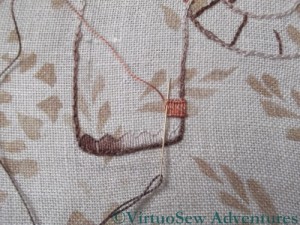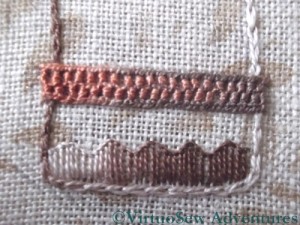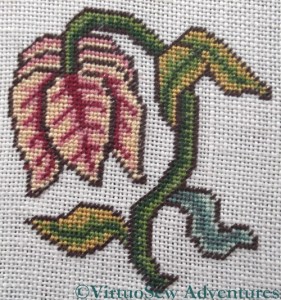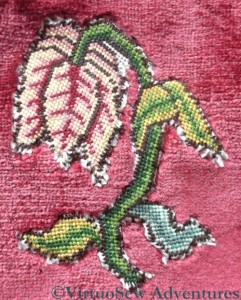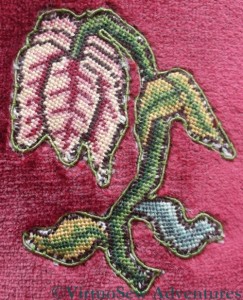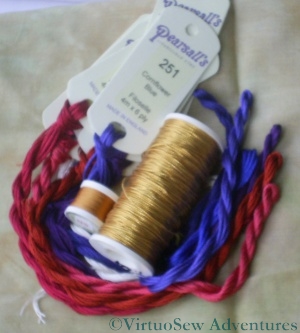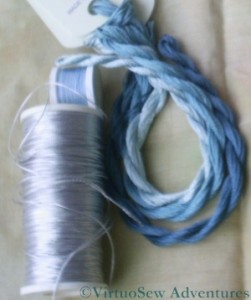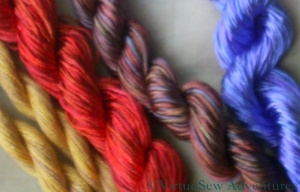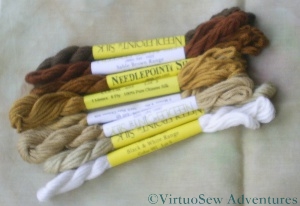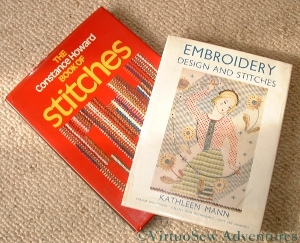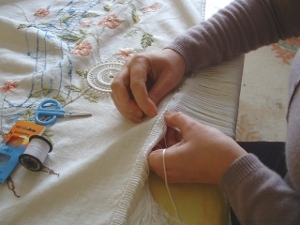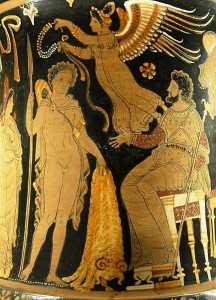Category: General Posts
Elephant’s Anklets Identified!
I’ve been struggling to decide what to do with the anklets for the Elephant of Infinite Charm. When I look at the Elephant without anklets it’s clear the design needs more visual weight lower down in the design, but when I asked the Elephant what sort of anklets he wanted, he just humphed at me. For days!
Now, however, I think I’ve cracked it. And one of the really pleasing things about the idea is that it helps me to practice my Ladder Stitch, which I’ve been struggling with for the Tudor and Stuart Goldwork Masterclasss. It’s easier in silk, partly because I’m not quite as conscious of the expense of the thread (I can’t believe I just wrote that!), and partly because the thread slides over itself more easily.
So here is my choice – ZigZag on Ladder Stitch. It adds a bit of patterning and structure , but it’s not out of scale with the Elephant or with his feet. The only slight difficulty is that because it it a complex stitch on top of a fairly complex foundation, it’s not exactly lightening-fast. Still, I’ve got one done, and the Elephant isn’t humphing anymore. When I’ve done both, I will need to decide whether to put a second anklet further up the leg. The original ceramic version does, but then in the ceramic version the anklet is smooth…
Progress on the Tulip Slip
I’ve now finished the tent stitch on the Tulip Slip Needlework Nibble.
I had a minor epiphany about halfway through, when I realised that in this particular case, absolute accuracy in colour placement isn’t really necessary. I’m not trying to create a picture which will look all wrong if every stitch isn’t exactly as charted. Tricia has created a stylised design which we are then going to use to learn the technique of working with tent stitch slips. So in minor details, the Tulip is not exactly as charted, but I doubt anyone will notice!
The next stage was to cut out the slip, and attach it to the velvet, turning the edges under as far as possible. I didn’t think this would be easy, and it wasn’t. Since linen for counted work is quite widely-sett (that is, the set up of the warp and weft allows a little air between the threads), it’s also rather prone to fray, and rolling the threads under with a needle turned out to be a slightly hairy experience.
On top of that – we all know that velvet “creeps”, don’t we? I unpicked and re-positioned the slip twice, and ended up pinning it firmly in place, regardless of the risk to my stitchery. I’m pleased to report that there seems to be no lasting damage…
The final stage before assembling the pincushion (that will be another post!) was to edge the slip with silk gimp. The green gimp matched one of the green silk threads, so I used a single strand to couch it down. Except that the various fabrics were sturdy enough to make it quite an effort to stitch through them, this enterprise proceeded as planned. The instructions showed the slip simply outlined as a single piece, rather than having any details of outlining each separate section.
In real life, the slip doesn’t look as ragged around the edges as it does in close up!
Thistle Threads Fundraising Needlework Nibble
Encouraged by the success of the Needlework Nibble that supported the Museum of Costume in Bath, Tricia at Thistle Threads has launched another fundraising Needlework Nibble, this time to support the exhibition With Cunning Needle: Four Centuries of Embroidery at Winterthur Museum.
I’ve enjoyed the Glittering Snail, and the two Thistle Threads courses I’ve been following, so I’ve ordered my kit, and the finishing kit to go with it. I’ve printed out the instructions, as well.
Tricia has already reported that the fundraising is going well – about halfway to the target, thanks to the generosity of one of her readers who has matched the first thousand dollars raised. That means there are still kits available, although they are clearly moving fast.
Why don’t you join us?
The Knitting and Stitching Show, Harrogate
Since I don’t have a convenient, well-stocked local embroidery shop, and have discovered over the years that colours often don’t display well on screen, leading me to spend lots of money on the wrong thread, I now concentrate almost all my embroidery shopping around one event: The Knitting And Stitching Show in Harrogate. I had a wonderful weekend there last week, and even managed to take tea at Betty’s Tearooms, and to visit the Royal Pump Room Museum which had few items from Amarna, as well as a rather fabulous painted and embroidered screen from the early 1900’s.
It’s particularly useful when I am planning to branch out into a form of embroidery I’ve not tried before. There are always stallholders with a deep knowledge of the particular technique I have in mind, and they are always willing to talk, and share tips and ideas.
This time I am planning two or nué pieces, so my first stop (after buying some merino/possum blend wristwarmers from Jamie Possum) was to visit The Golden Hinde. I described what I had in mind, and soon had a spool of gold and a spool of silver to use for those pieces. Then on to the Pearsall’s Embroidery stand to buy the silk to couch it down with. I’m not sure how much I will need, so I bought one skein of each colour. Since these are single colour threads, I can re-order if I need to.
I also bought some more turban cotton and faience-coloured threads from Stef Francis and from Oliver Twist, and some silk threads to make another attempt at the Dig House. I’ve been looking for threads that resemble some of the other colours I will need for the Dreams of Amarna panels – the carnelian and jasper and other semi precious stones the Egyptians used, but some of those aren’t so easy to find. I am going to need to do some more reading in my references to get a clear idea of some of the colours I will need.
I’ve found I’ve bought more silk threads than cotton, this time around. All this work using silk for the Floral Glove Needlecase Course and the Tudor and Stuart Goldwork Masterclass is changing my habits!
A view from my bookshelf. . .
Like so many of us, I have probably several shelves’ worth of books about embroidery scattered around the house. Some of them never make it back to the shelves because they are always beside me as I work (Barbara Snook’s “Embroidery Stitches” and Yvette Stanton’s “The Right Handed Embroiderer’s Companion“), some of them are put aside for study when I have leisure (when will I learn?), but the rest of them are shelved (not all in the same place) ready to be pulled out to give me entertainment and pause for thought.
One of those is Kathleen Mann’s “Embroidery Design and Stitches”, first published in 1937. Kathleen Mann trained at the Royal College of Art, but went to teach at The Glasgow School of Art, at about the time this book was published. Looking at the stitch diagrams and the design ideas she presents, they are very much of the Thirties, of a particular modern, exuberant style that occasionally is found in the designs in that stack of The Needlewoman Magazine that I inherited. So it is not surprising that in the text I find her bewailing the fact that so much of the embroidery of that time was backward-looking, expressions not of modern sensibility but of indebtedness to the past. Certainly if you look at some of the “Jacobean work” designs in The Needlewoman, some of them are rather stiff, dark and charmless. A little oppressed by scholarship, perhaps, like some of the authentic performance practitioners in the early music movement (for an antidote to that problem, if you like baroque music but don’t take it too seriously – get to a performance by Red Priest!).
When I look at “Constance Howard’s Book of Stitches“, further along the shelf, I find the stitch samplers illustrating it also speak vividly of their time – in this case the 1970s. Strong, bold, and abstract, often using heavy fabrics and threads – certainly much heavier than would have been used in the Thirties – and not quite so “careful”. Perhaps, more accurately I should say – the embroiderer clearly has a good technique, but chooses for the purposes of her sampler to vary the size and shape of some of her stitches, sometimes rather chaotically.
Then again, I have been reading one of Jill Paton Walsh’s “Imogen Quy Mysteries”, in which part of the plot turns on the dating of antique patchwork quilts from both the pattern and the fabrics used (print styles can be dated).
Suddenly I find myself thinking – what are we doing? What am I doing? If someone were to look at my embroidery in thirty, forty years’ time, how will it appear to them? Stiff, derivative and uninspired? Or will it speak of the times in which it was made? What is it that is characteristic of our time? When we look at a film made in the Eighties, we don’t need to see the end credits or look it up on IMDB.com to know that it was made in the Eighties, yet at the time, had we seen it, the clues we now use wouldn’t have registered at all.
Of course, we can learn an enormous amount about embroidery and embroiderers by studying and replicating past work. I don’t think Kathleen Mann would have disapproved of that, and I certainly don’t. I enjoy the exuberance of Jacobean work, and I am fascinated by the two online university courses I am following.
But it is an interesting question for all of us who create anything, all the same. Is my work modern, current, inspired by the past, or is it hidebound by the past, backward looking, a pale imitation of past glories?
Quietly Persevering
I’m in the very last stages of a very long running commission here. It’s one of the reasons my reading of blogs has been sporadic of late – I’ve been working very hard on this!
Anyway, the last stage is to add fringing all around the edge – some six metres of fringing, which is why it isn’t happening all in one go – although we will need the dining room table again soon (I don’t have a studio – I only wish I did!). And I am using the pins I won in a giveaway on Karen’s blog recently – thank you, Karen, they are working very well for this!
I’ve learnt a lot from this project about managing, planning and specifying a commission. In particular, unless you can be guaranteed no disturbances, life has a tendancy to throw in the odd curve ball and suddenly progress slows to a crawl. It took over a year to find a suitable fabric that my client and I both liked, and over six months to find the fringing. Fortunately I haven’t had a hard deadline – my client wants it finished suitably and not rushed. That makes life much easier!
I also discovered that I have a tendancy not to work on what I want to work on, unless I can put forward an over-riding reason why I should. “I’m being paid” works, but so does “I want to write it up for my blog” (now I have a blog, that is!) or “I’m learning something here”. What hasn’t worked – until recently – is “I’m enjoying it”.
Still, it’s within eyeshot of being finished, now. Another day on the fringing, and then I shall take some photos from the right side before presenting it to my client. I’ll post those after she has seen it!
Piracy Follow Up – Two
I don’t like producing very long posts, so when I realised how much was going to be involved in a synthesis of the conversations about digital piracy that I had a few weeks ago, I decided to split the follow-up into two. This post is the second of those follow-ups, so there are now three posts, the original, the first follow-up, and this one.
Before describing the various business models that have been suggested, I thought I should give some idea of what is involved in producing a design chart, for those who haven’t thought of it before.
In producing a design for hand-embroidery, the designer spends hours thinking about the design, planning and re-drafting it, then working it and developing instructions for her customers to follow. If you’ve never written instructions – try it. Then give them to someone who doesn’t know anything about what you have written about and see how well they do.
It isn’t easy. In fact, just preparing instructions can take hours.
Furthermore, if a design is to be issued only as a chart, and not as a kit of materials, there are (in the UK, at least) three main thread manufacturers whose colour numbers need to be included. There are conversion charts, but I’ve often found that the results are unsatisfactory and need to be checked and corrected by hand.
Unless the designer is supported by a spouse or family, or has another job that pays the bills, all that time needs to be paid for somehow, or they will run out of money and need to do something else in order to eat.
The current business model – in essence – is that the hobbyist stitcher purchases a kit or a chart from which to work, perhaps because they lack confidence in their design abilities, effectively “outsourcing” the design work. The pricing for a kit or chart doesn’t include all the design costs because the designer or manufacturer hopes to sell a large enough number that those costs can be amortised over the print/manufacturing run. A full kit includes all necessary materials, and while they can be illicitly produced, that’s not common. A chart, however, is just a piece of paper showing the design, colour key and instructions, and is therefore very easily replicated. Indeed, a design that was never issued electronically can be scanned and saved as a PDF and suddenly that, too is online – possibly even lacking one of the crucial elements (such as the key).
The sale of charts in the form of PDFs is really a simple translation of this basic process to the web-enabled world. It has the merit of providing instant gratification (insofar as the chart is immediately available for the customer to print out and use), but there is the risk of abuse, in that others may offer the same item without paying the designer.
I was reminded, by one of the comments, that there is no copyright in the fashion industry, which nonetheless seems to be flourishing. I confess that I can’t quite see a way for the needlework world to make the same model work, since it relies on the fact that the people who buy high street copies of designer garments wouldn’t be able to afford the original pieces, but it’s a point to bear in mind. I’m not even sure what analogy one can make between sales of high street fashion and embroidery charts that would be illuminating, although I feel there should be one. Charts perhaps equate to dressmaking patterns, but certainly not to high street fashion.
In addition, as we are all aware by now, the open source movement in software has entire businesses working within it, even though the product (such as a browser) may be free. In fact, however, these businesses are selling, not software, but support. Perhaps the needlework equivalent would be workshops and courses. There are even courses being delivered online now, although the necessary precautions against illicit use of copyright material must put a significant technical overhead on them.
There were other business models suggested to me, too:
- Building a community around free designs. The suggestion is that this might even increase the size of the market by making access easier to new customers (again, there is a technical overhead here).
- Custom design – that is, individually personalised designs for individual customers (only for those with the hide of a rhinoceros – or those who can pick their customers carefully!).
- Cataloguing – the sale of temporary access to a catalogue of existing designs. This could be used to build up in effect a curated assembly of charts which would be of guaranteed quality – not something that can be said of informal file-sharers’ offerings. I think this would involve a technical overhead as well, although there may be an existing system based on those used by eBook providers.
- An honesty-based system for payment, such as flattr
- Escrowed prepayment, y similar to the way in which Mozart and Beethoven arranged their subscription concerts (which suggests that it would be most suitable for creators of art for public display)
- Creators funded by the state based on the popularity of their work (this perhaps would work for textile artists, but not for designers of kits for hobbyists to stitch at home)
- Distribute hardcopy via shops rather than via internet (this is still done, but is increasingly difficult as shops close)
If I seem to be picking holes in many of these ideas, it isn’t because I don’t believe they are good ideas or because I want them to fail. It is simply because I want to make it clear that this is going to be a really difficult problem to solve, and there are going to be artists and craftsmen and women who will suffer until a new model is created, a new market is created, or until the existing market is educated enough to realise how much work goes into the things they take for granted.
—
Thanks to: Davide ‘Folletto’ Casali, Robert Bronsdon, Mace Moneta, Harleqin, Alex, Eric Larson, Ed Marshall, Philip Hunt, Posy, and Janice.
Piracy Follow-Up – One
A few weeks ago, I wrote a post about designs being shared without the designer’s approval, and suggested that it isn’t right to do so. The post was linked to on HackerNews; then on a few more tech blogs and suddenly the whole subject was attracting attention and comments from a new range of people, and people, what’s more, who have an interest in the subject of copyright – software piracy is a problem too.
It became clear in the course of reading the comments, and the links, and the emails I received, that in fact (debates over ethics and terminology notwithstanding) most of my correspondents felt that the copyright and intellectual property system as it stands is ill-adapted to our digital world, and needs changing. As to how – none of us is very sure about that.
Essentially, the comments and emails fell into two categories: philosophical discussions of how/why the situation is as it is, and suggestions for new business models that might meet the changing circumstances. I’ve split my follow-up into two posts along the same lines.
First, though, my terminology was imprecise, so yes, technically, the unauthorised copying of a digital work is not theft, but copyright infringement.
Second, (going back to Monique’s original post on Inside Number Twenty) I acknowledge that when we see x downloads from the file-sharer, it probably doesn’t equate to x lost sales.
That isn’t the point, though, is it? The real point is that ease of copying has undermined the general appreciation of the value of the item in its digital form.
Any creative work already tends to be undervalued because non-creative people assume that talent does all the work. It is assumed that if you are talented, creating something comes easily (haven’t we all encountered that one?). We who create things know that this isn’t true, that talent needs to be supported by time, effort, and application. Thomas Edison was right when he said that genius is composed of 99% perspiration and 1% inspiration.
So there is a problem of education here. The consumer needs to be reminded that creation isn’t simply a matter of snapping one’s fingers, that the artist may have devoted years to learning their craft before being able to produce anything for the market, quite apart from the time they spend in refining their vision to create the final piece. They need to understand that when they use or enjoy a digital copy of a copyrighted artistic work for which they have not paid, the artists whose work they enjoy are the ones who suffer, even if in the case of music and films it is the big media companies that complain.
Taking the specific example of the needlework business – most of the companies, even those producing threads and tools, are really very small. They don’t have a huge financial buffer, and they can be as easily unbalanced by sudden success as by a fall in sales. The companies producing charts often aren’t companies, but just one person, trying to make a living in a way that fits around other obligations.
Even those of us who are not immediately affected, perhaps because we design most of our own pieces, need to remember that the sale of charts and designs supports and encourages the sale of threads, fabrics, tools and charms. If the designers go out of business we may very well find that manufacturers do as well. And we know that we don’t want that.
Perhaps, though, the current business model is truly unworkable, and a new one is needed. I’ll describe some of the suggestions I’ve been sent in another post.
—
Thanks to: Davide ‘Folletto’ Casali, Robert Bronsdon, Mace Moneta, Harleqin, Alex, Eric Larson, Ed Marshall, Philip Hunt, Posy, and Janice.
Piracy isn’t cool
Forget Peter Ustinov playing Blackbeard or Johnny Depp as Captain Jack Sparrow – piracy isn’t cool, it isn’t clever, and there is nothing endearing about it!
I don’t usually attempt to produce topical posts – my embroidery is a very long-term sort of occupation! – but I care about the health of the needlecrafts industry, and there is something we all need to be aware of. I’ve let my thoughts settle over the weekend, and this is my two-pennyworth.
Monique over at Inside Number Twenty has recently discovered her charts being “shared” without her permission and has done a few sums to see what the actual financial costs are to her and to the other businesses associated with hers. The results make sobering reading. No wonder designers are shutting up shop, as Jen Funk Weber reports – not merely because designs are being “shared” (read “pirated”), but because people are downloading free charts rather than paying for a designer’s work. Eventually the designers will have to do something else to earn a living, and then the range of designs available will no longer develop and grow.
A few months ago Tricia Wilson also discussed the financial and social aspects of needlecrafts in a post on The Embroiderer’s Story. There’s a great deal of subtle interplay between the buying decisions we make and the ongoing effects that spread throughout the industry.
The music industry has been complaining about piracy ever since file-sharing became possible, and has been ignored because people consider that pop stars make so much money they won’t miss the few pounds from file-sharers. Maybe, maybe not. I don’t know about margins in the entertainment industry, so I can’t comment on that.
Copyright and intellectual property law was originally devised to support and encourage artists – in all media – so that society as a whole can benefit from their work, while they receive just recompense for their efforts.
As for needlecrafts – most of the businesses are so small that “industry” conjures up entirely the wrong image. The margins are small, and loss of even a small portion of revenue may make a difference between a viable business and a designer giving up and getting a non-creative job to pay the bills.
As Yvette has already commented, sharing a copyrighted design is theft. There are a whole range of people who suffer as a result, including ordinary people who enjoy stitching and would never dream of using a pirated chart.
We were all told at kindergarten that theft is wrong. How come people have forgotten?
Planning The Golden Fleece
I know Janice suggested I should finish the Dreams of Amarna before getting wound up in The Golden Fleece, but I had a long train journey recently, and started idly thinking about the idea.
So:
Obviously, the scene to do is the one where Medea takes Jason into the grove where the Fleece is kept.. Lots of twisted branches and tree trunks, the sun sinking low in the west, and the Fleece glimmering in the light of the torches.
The first design challenge that occurs to me is that the Fleece will over dominate the picture if I am not careful with all that textured, gleaming gold. On the other hand, gold looks better with a dark, rich coloured background, so I can’t just settle for a daytime scene.
I can ease the problem slightly by dressing Jason and Medea in their best clothes, with rich colours and gold details, and perhaps rather than sunset, have it in moonlight (cue a silver kid moon!), with a line of torches to indicate the approach to the grove.
If I make sure that the Fleece has several shades of gold in it, that may also settle it more happily into place as only part of the panel..
There are several books I can use for reference – Tim Severin built a replica of the Argo and sailed and rowed from Greece to Georgia, which is where Colchis is thought to have been. Robert Graves wrote on the subject. I’ll have little trouble finding other references, either. We’re back to myths, legends, and archaeology…

